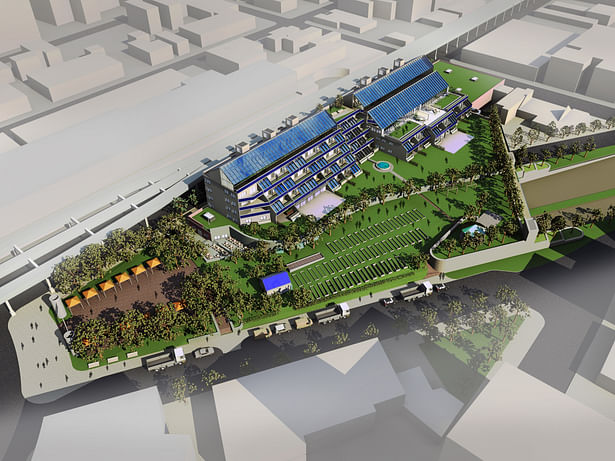

BronxBridge ECohousing; an exploration of Urban Cohousing and Urban Agriculture on a bridge renewing pedestrian connections across the Cross Bronx Expressway.
Colin Healy, City College of New York Spitzer School of Architecture, May 27, 2010
Thesis Statement: Urban Cohousing in the Bronx
Studio Critic: Professor Lance Jay Brown
Cohousing represents the convergence of several positive trends in housing and society.
Community: Many people have recognized the need in their lives to have deeper relationships with their neighbors and their larger communities.
Self Reliance: Cohousing projects are cooperatively designed and developed by their future residents
Affordability: Smaller units, high density and minimizing the developer’s role can lower building costs.
Zero-Energy: Community heating and cooling systems and on-site food production are possible. Community and private gardens can be supported. A large rooftop urban agriculture project may provide a rationale for the costs of infrastructure.
Cohousing is built upon the historical precedents of social housing experiments like Narkomfin, without the imposition of design decisions dictated from above. The first cohousing project was formed in 1972 in Denmark by an architect. Typically, a group of individuals come together and consciously choose to create a community. Decision making is most often by consensus. The size and arrangement of units is influenced by the re-allocation of some space from each of the housing units to allow the creation of a common facility for shared activities, guest accommodations, office space, child care, shared meals, etc. Units are owned individually.
Program: I based my program on precedents of a variety of solutions that have been implemented, both in the US and Europe, as a foundation for innovation. The community I explored consists of approximately 70 dwelling units in 2 connected buildings with 2 common areas for dining and social activities. The project allowed me the opportunity to look into design of units for people of various ages and stages of life. Aging in place, working at home and child care options are explored.
The program includes on-site food production, employing solar greenhouses and rooftop gardens and links to a community garden. A special interest of this client group is living lightly on the earth. Techniques for harvesting and conserving all available energy and material resources on the building site have been incorporated. Prefabrication methods were also evaluated. The majority of the examples of cohousing in the United States are suburban or rural, often only one or 2 stories high. This project is an urban expression of the typology with urban density requiring buildings of at least 3 stories.
Site Selection. My project was part of a larger investigation in the thesis studio that explores ways of reconnecting the communities divided by the imposition of the Cross-Bronx Expressway. The selection of a site came from an analysis of the most advantageous places to attempt to reweave the urban fabric of the Bronx across the barrier created by the highway. We chose a site in Parkchester at the multi-level intersection of Metropolitan Avenue, the elevated subway and the Expressway.
The themes of unity, cooperation and community that are the essence of cohousing are a fitting metaphor for the larger project. It includes re-envisioning the aging Parkchester Subway Station into a Transit Hub by Parichard Yingvararuk and a creation of a regional Montessori School by Kahn Shibly. This scenario sought to establish linkages between our proposals and the existing
communities while improving existing infrastructure. The BronxBridge Ecohousing Transit Oriented Development is located on a proposed 2 acre cap over the Cross Bronx Expressway and rebuilds pedestrian links to the divided neighborhoods. Acknowledgements In earlier documents,
Credits: I have included a thorough program for site design, unit design and common house planning based on Mosaic Commons by Kraus-Fitch Architects. Also included is a documentation of the planning process for Columbia Ecovillage Common House from Charles Durrett of the Cohousing Company.
Status: School Project
Location: Parkchester, Bronx, New York